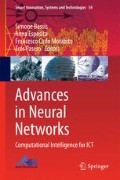Abstract
We extend the Fuzzy Inference System (FIS) paradigm to the case where the universe of discourse is hidden to the learning algorithm. Hence the training set is constituted by a set of fuzzy attributes in whose correspondence some consequents are observed. The scenario is further complicated by the fact that the outputs are evaluated exactly in terms of the same fuzzy sets in a recursive way. The whole works arose from everyday life problems faced by the European Project Social&Smart in the aim of optimally regulating household appliances’ runs. We afford it with a two-phase procedure that is reminiscent of the distal learning in neurocontrol. A web service is available where the reader may check the efficiency of the assessed procedure.
Access this chapter
Tax calculation will be finalised at checkout
Purchases are for personal use only
Notes
- 1.
- 2.
In the experiments each rule receives in input also a crisp variable corrisponding to the operational parameter, i.e. the rising time in the example, outputted by the FIS at the previous iteration.
- 3.
Actually, for each fuzzy variable \(g_i\), the output (3) of layer 0 is further processed so as to include as last step this transformation.
- 4.
The database is available at http://ns3366758.ip-37-187-78.eu/exp/excel.
References
Apolloni, B., Fiaschè, M., Galliani, G.L., Zizzo, C., Caridakis, G., Siolas, G., Kollias, K., Grana Romay, G., Barriento, F., San Jose, S.: Social things—the SandS instantiation. In: Second IEEE Workshop on the Internet of Things: Smart Objects and Services, IoT-SoS 2013 (2013)
Apolloni, B., Galliani, G.L., Gioia, M., Bassis, S., Rota, J., Ferrari, L.: Social things: now we can. Intelligenza Artificiale 9(2) (2015)
Cococcioni, M., Lazzerini, B., Marcelloni, F.: Estimating the concentration of optically active constituents of sea water by Takagi-Sugeno models with quadratic rule consequents. Pattern Recogn. 40(10), 2846–2860 (2007)
Jang, J.S.R.: ANFIS: adaptive-network-based fuzzy inference system. IEEE Trans. Syst. Man Cybern. 23(3), 665–685 (1993)
John, S.: The three-parameter two-piece normal family of distributions and its fitting. Commun. Stat. Theor. Methods 11(8), 879–885 (1982)
Jordan, M.I., Rumelhart, D.E.: Forward models: supervised learning with a distal teacher. Cogn. Sci. 16(3), 307–354 (1992)
Miu, S., Hayashi, Y.: Neuro-fuzzy rule generatioion: survey in soft computing framework. IEEE Trans. Neural Netw. 11, 748–768 (2000)
Nauck, D., Klawonn, F., Kruse, R.: Foundations of Neuro-Fuzzy Systems. Wiley, New York, NY, USA (1997)
Parmenter, D.: Key Performance Indicators: Developing, Implementing, and Using Winning KPIs, 2nd edn. Wiley, Hoboken (2010)
Pedrycz, W.: The principle of justifiable granularity and an optimization of information granularity allocation as fundamentals of granular computing. J. Inf. Process. Syst. 7(3), 397–412 (2011)
Rabiner, L., Juang, B.: An introduction to hidden Markov models. IEEE Acoust. Speech Sig. Process. Mag. 3, 4–16 (1986)
Robertson, C.A., Fryer, J.G.: Some descriptive properties of normal mixtures. Scand. Actuar. J. 1969(3–4), 137–146 (1969)
Werbos, P.J.: The Roots of Backpropagation. From Ordered Derivatives to Neural Networks and Political Forecasting. Wiley, New York, NY (1994)
Wu, Q., Hogg, B., Irwin, G.: A neural network regulator for turbogenerators. IEEE Trans. Neural Netw. 3(1), 95–100 (1992)
Zadeh, L.: Fuzzy sets. Inf. Control 8, 338–353 (1965)
Acknowledgments
This work has been supported by the European Project FP7 317947 Social&Smart.
Author information
Authors and Affiliations
Corresponding author
Editor information
Editors and Affiliations
Rights and permissions
Copyright information
© 2016 Springer International Publishing Switzerland
About this paper
Cite this paper
Apolloni, B., Bassis, S., Rota, J., Galliani, G.L., Gioia, M., Ferrari, L. (2016). Learning from Nowhere. In: Bassis, S., Esposito, A., Morabito, F., Pasero, E. (eds) Advances in Neural Networks. WIRN 2015. Smart Innovation, Systems and Technologies, vol 54. Springer, Cham. https://doi.org/10.1007/978-3-319-33747-0_10
Download citation
DOI: https://doi.org/10.1007/978-3-319-33747-0_10
Published:
Publisher Name: Springer, Cham
Print ISBN: 978-3-319-33746-3
Online ISBN: 978-3-319-33747-0
eBook Packages: EngineeringEngineering (R0)

